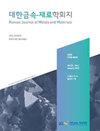Piezoresistive Characteristics of Carbon Nanotube Polymer Composites with Different Filler Content and Aspect Ratio for Pressure Sensors
IF 1.1
4区 材料科学
Q4 MATERIALS SCIENCE, MULTIDISCIPLINARY
引用次数: 0
Abstract
Polymer composites enriched with conductive fillers hold immense potential for flexible pressure sensors, because of the remarkable piezoresistive effect they possess. Research on polymer composite pressure sensors has been actively ongoing because of their flexibility and high electrical resistance performance. This paper presents a comprehensive comparison of the piezoresistive characteristics of conductive composites for pressure sensors, focusing on the influence of carbon nanotube (CNT) content and aspect ratio. Polymer composites with conductive fillers, specifically CNTs, have demonstrated significant potential for pressure sensing applications based on the piezoresistive effect. By systematically varying the CNT concentration and aspect ratio, we investigated the impact of these parameters on the piezoresistive behavior of the composites. A pressure in the range of 0-200 kPa was applied to the conductive composite, and resistance change due to pressing was measured. The best performing samples were evaluated in 150 cycle tests to verify repeatability and durability. Experimental analysis and characterization revealed the intricate relationship between CNT content, aspect ratio, and the resulting piezoresistive properties. Through this study, we aim to enhance understanding of how CNT concentration and aspect ratio influence the performance of CNT/PDMS composites as pressure sensors, thereby facilitating the development of optimized sensing materials for various pressure sensing applications.不同填料含量和长径比的压力传感器用碳纳米管聚合物复合材料的压阻特性
富含导电填料的聚合物复合材料具有显著的压阻效应,在柔性压力传感器中具有巨大的潜力。聚合物复合材料压力传感器因其柔性和高电阻性能而得到了广泛的应用。本文全面比较了用于压力传感器的导电复合材料的压阻特性,重点研究了碳纳米管(CNT)含量和宽高比对其压阻特性的影响。具有导电填料的聚合物复合材料,特别是碳纳米管,已经显示出基于压阻效应的压力传感应用的巨大潜力。通过系统地改变碳纳米管浓度和长径比,我们研究了这些参数对复合材料压阻性能的影响。对导电复合材料施加0- 200kpa的压力,测量其受压后的电阻变化。在150次循环试验中对性能最好的样品进行了评估,以验证可重复性和耐久性。实验分析和表征揭示了碳纳米管含量、纵横比和压阻性能之间的复杂关系。通过本研究,我们旨在加深对碳纳米管浓度和宽高比如何影响碳纳米管/PDMS复合材料作为压力传感器性能的理解,从而促进开发用于各种压力传感应用的优化传感材料。
本文章由计算机程序翻译,如有差异,请以英文原文为准。
求助全文
约1分钟内获得全文
求助全文
来源期刊

Korean Journal of Metals and Materials
MATERIALS SCIENCE, MULTIDISCIPLINARY-METALLURGY & METALLURGICAL ENGINEERING
CiteScore
1.80
自引率
58.30%
发文量
100
审稿时长
4-8 weeks
期刊介绍:
The Korean Journal of Metals and Materials is a representative Korean-language journal of the Korean Institute of Metals and Materials (KIM); it publishes domestic and foreign academic papers related to metals and materials, in abroad range of fields from metals and materials to nano-materials, biomaterials, functional materials, energy materials, and new materials, and its official ISO designation is Korean J. Met. Mater.
 求助内容:
求助内容: 应助结果提醒方式:
应助结果提醒方式:


